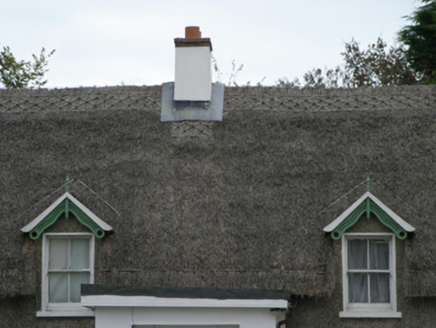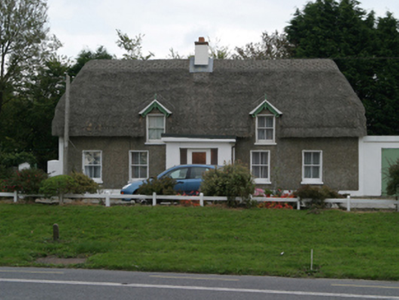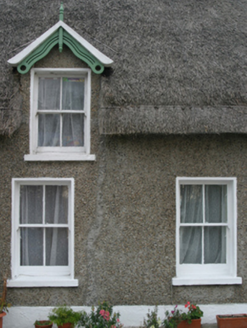Survey Data
Reg No
15704786
Rating
Regional
Categories of Special Interest
Architectural, Social
Original Use
House
In Use As
House
Date
1700 - 1840
Coordinates
305084, 113693
Date Recorded
20/10/2007
Date Updated
--/--/--
Description
Detached three- or five-bay single-storey lobby entry thatched house with dormer attic, extant 1840, on a T-shaped plan centred on single-bay single-storey flat-roofed projecting porch. "Improved", ----, producing present composition. Reroofed, ----. Chicken wire-covered replacement hipped oat thatch roof centred on gablets to window openings to dormer attic with exposed hazel lattice stretchers to ridge having exposed scallops, cement rendered central chimney stack having red brick corbelled stepped capping supporting terracotta pots, decorative timber bargeboards to gablets with timber finials to apexes, and exposed hazel stretchers to eaves having exposed scallops. Gritdashed roughcast battered wall to front (west) elevation on rendered plinth with rendered "bas-relief" strips to corners; cement rendered surface finish (remainder). Hipped square-headed central door opening with concealed dressings framing replacement glazed uPVC door having sidelights. Square-headed flanking window openings with concrete or rendered sills, and concealed dressings framing two-over-two timber sash windows. Set back from line of road on a slightly elevated site.
Appraisal
A house identified as an integral component of the vernacular heritage of south County Wexford by such attributes as the compact rectilinear lobby entry plan form centred on an expressed, albeit later porch; the construction in unrefined local materials displaying a battered silhouette with sections of "daub" or mud suggested by an entry in the "House and Building Return" Form of the National Census (NA 1901; NA 1911); the somewhat disproportionate bias of solid to void in the massing; and the decorative timber work embellishing a high pitched roof showing a replenished oat thatch finish. Having been well maintained, the elementary form and massing survive intact together with substantial quantities of the historic or original fabric, both to the exterior and to the interior, thus upholding the character or integrity of a farmhouse making a picturesque visual statement in a rural street scene.





